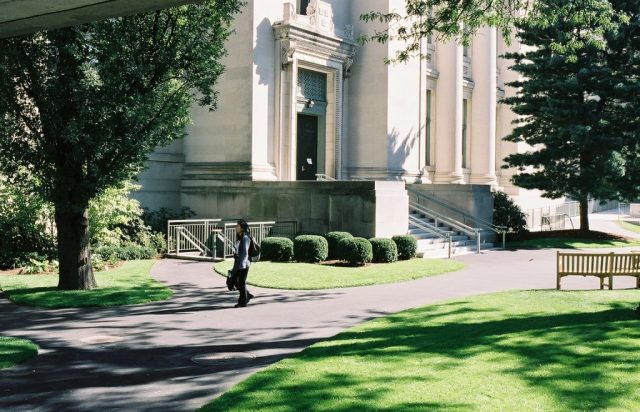
Photo by: Brooks Kraft
Post by: Jackie Kim and Lisa Brem
Why should legal educators use case studies and other experiential teaching methods, such as role plays and simulations, in their classes? Hasn’t the Langdell method served legal education well these last 140 years? Certainly creating and using experiential materials requires a different set of skills from faculty, elicits a different response and level of engagement from students, and poses barriers to implementation. The ABA’s LEAPS Project[i] has a comprehensive list of objections to practical problem solving in the classroom: materials are time consuming and expensive to create and deploy; addition of a case study or simulation to a syllabus inherently displaces other material; and there are few incentives from law school leaders to introduce this type of teaching.
Yet, the argument promoting experiential materials and techniques is strong. The 2007 Carnegie Report[ii] recommended integrating lawyering skills practice into the curriculum alongside doctrinal courses, and the ABA added simulation courses to the list of practical experiences that can and should be offered by law schools in its 2015 Guidance Memo[iii].
In a 2007 Vanderbilt Law Review article[iv], HLS Dean Martha Minow and Professor Todd D. Rakoff argued that Langdell’s approach to teaching students using appellate cases does not do enough to prepare law students for real-world problems: “The fact is, Langdell’s case method is good for some things, but not good for others. We are not talking about fancy goals here; we are talking about teaching students ‘how to think like a lawyer.’”
But does the case study method result in a higher degree of student learning? While we have not yet seen a study on the efficacy of the case study method vs. the Langdell method in law schools, research[v] from political science professor Matthew Krain suggests that case studies and problem-based activities do enhance certain types of learning over other types of pedagogy. In his investigation, Krain compared the results of pre-and post-course surveys of students who participated in active learning with those who received a traditional lecture course. The case studies and problems that Krain used in his non-traditional classes included: case studies in the form of popular press articles, formal case studies, films, or problem-based case exercises that required students to produce a work product.
Krain found that:
Student-centered reflection, in which students have the opportunity to discuss their understanding of the case, allows both students and instructors to connect active learning experiences back to a larger theoretical context. Case learning is particularly useful for dramatizing abstract theoretical concepts, making seemingly distant events or issues seem more “authentic” or “real,” demonstrating the connection between theory and practice, and building critical-thinking and problem-solving skills (Inoue & Krain, 2014; Krain, 2010; Kuzma & Haney, 2001; Lamy, 2007; Swimelar, 2013).
[…]
This study suggests that case-based approaches have great utility in the classroom, and they should be used more often in instances where students’ understanding of conceptual complexity or knowledge of case details is critical. Moreover, case-based exercises can be derived from a variety of different types of materials and still have great utility. If deployed selectively in the context of a more traditional classroom setting as ways to achieve particular educational objectives, case-based approaches can be useful tools in our pedagogical toolbox.
For those who might be ready to try a case study, role play, or simulation, there are resources that can help. Harvard Law School produces case studies for use throughout the legal curriculum. The HLS Case Studies program publishes these teaching materials, and makes them available to educators, academic staff, students, and trainers. Outside of Harvard Law School, links to resources for educators implementing the case study method can be found on the Case Studies Program Resources page. Listed are case study affiliates at Harvard, legal teaching and learning tools, tips for case teaching, and free case materials. Examples include the Legal Education, ADR, and Practical Problem Solving (LEAPS) Project[vi] from the American Bar Association, which provides resources for various topics on legal education, and the Teaching Post, an educators’ forum offered by the Harvard Business School where professors can seek or provide advice on case study teaching.
“… [O]ur society is full of new problems demanding new solutions, and less so than in the past are lawyers inventing those solutions. We think we can, and ought to, do better.” – Dean Martha Minow & Professor Todd Rakoff.[vii]
[i] “Overcoming Barriers to Teaching ‘Practical Problem-Solving’.” Legal Education, ADR & Practical Problem-Solving (LEAPS) Project, American Bar Association, Section of Dispute Resolution. Accessed March 16, 2017, http://leaps.uoregon.edu/content/overcoming-barriers-teaching-%E2%80%9Cpractical-problem-solving%E2%80%9D.
[ii] William M. Sullivan, Anne Colby, Judith Welch Wegner, Lloyd Bond, and Lee S. Shulman, “Educating Lawyers,” The Carnegie Foundation for the Advancement of Teaching (2007).
[iii] American Bar Association, “Managing Director’s Guidance Memo,” Section of Legal Education and Admissions to the Bar (2015).
[iv] Martha Minow and Todd D. Rakoff, “A Case for Another Case Method,” Vanderbilt Law Review 60(2) (2007): 597-607.
[v] Matthew Krain, “Putting the learning in case learning? The effects of case-based approaches on student knowledge, attitudes, and engagement,” Journal on Excellence in College Teaching 27(2) (2016): 131-153.
[vi] “Overcoming Barriers to Teaching ‘Practical Problem-Solving’.”
[vii] Minow and Rakoff.
